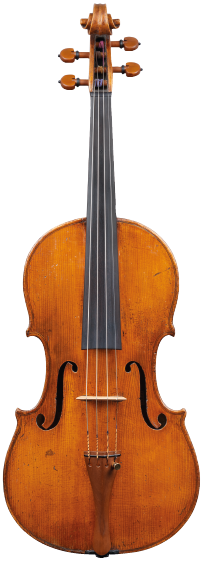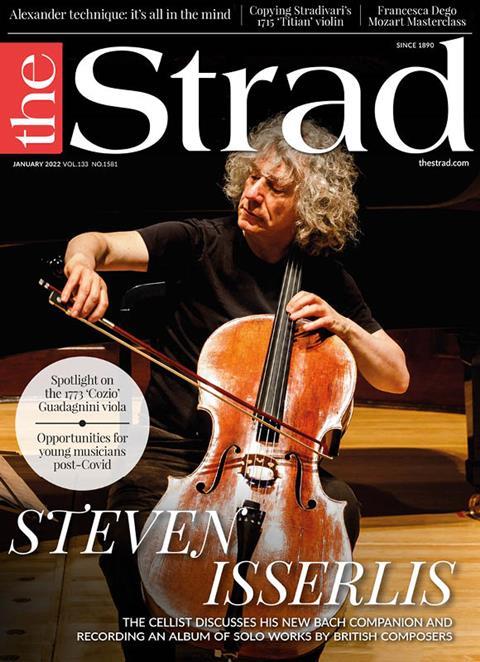Alberto Giordano and Barthelemy Garnier examine the business agreement between G.B Guadagnini and Count Cozio di Salabue that allowed the luthier to create a new style of viola, in this excerpt from the January 2022 issue

The following extract is from The Strad’s January 2022 issue feature ‘1773 “Cozio” Guadagnini Viola: The Only Constant Is Change’. To read it in full, click here to subscribe and login. The January 2022 digital magazine and print edition are on sale now
Discover more lutherie articles here
In 1816, the famed collector Count Ignazio Alessandro Cozio di Salabue entrusted a number of his instruments to his friend Carlo Carli, a Milanese banker, for him to sell. In the inventory he wrote: ‘the best viola of mine made by Giambattista Guadagnini [in] 1773; joined back with light flames, fine front of one piece, the beautiful f-holes with almond [oval] holes, the bold scroll.’ More than 40 years after purchasing it, the Count was still fond of this viola, one of the two made for him by Guadagnini and among the very first batch of instruments acquired by the Count. The agreement between the young aristocrat and the violin maker was signed on 28 December 1773, but the collaboration had started earlier: the six violins and two violas were a significant part of Guadagnini’s production for that year. They were made during the mourning period for the death of Charles Emmanuel III of Savoy, King of Sardinia, during which any theatrical or musical performance was prohibited.
Guadagnini and his family arrived in Turin from Parma in 1771. The capital of the Kingdom of Sardinia was the right choice for many reasons: Turin in the second half of the 18th century was going through a significant expansion that sprawled over the medieval old town. King Charles Emmanuel had consolidated the territory after the War of the Austrian Succession, and the population grew from 60,000 in 1741 to 90,000 in 1790. Musical activity flourished, not only in the Royal Chapel (established in the 15th century) and in the main theatres, but also in chamber music settings involving wealthy amateur players. The growing market for musical instruments in France could have been attractive for Guadagnini as well; moreover, there were still no professional violin makers in town, only makers of plucked instruments.
In 1773, through the middleman Giovanni Michele Anselmi, Guadagnini signed a contract with Count Cozio, who was then only 18 years old. It stipulated that the maker would deliver a considerable number of instruments in return for a regular income. Some time later, the Count gradually pushed the maker towards a more Cremonese style of work; but in the short term it gave Guadagnini the chance to experiment in his making. This is borne out in the viola shown here: both the mould and the design are quite different from the violas he made in Parma.
Although oriented towards the contralto size of Antonio Stradivari, it shows Guadagnini’s innovative approach. The length of the back (taken with a flexible ruler) is 401mm and the width of the body is enlarged, especially at the C-bouts. This makes a difference to the placing of the f-holes: the distance between the upper eyes is extended up to 56mm, while the flat and high archings are conceived for getting the strongest sound possible for this size.
With the growth in activity of professional musicians in theatres, music halls and aristocratic houses, the viola market had changed significantly in the second half of the 18th century: viola players were often employed non-salaried, and many were violinists who alternated between the two instruments. Today it is rare to come across an Italian viola bigger than contralto size, and luthiers were often asked to build violas less than 400mm, even down to 375mm. In addition, the role of the viola in music composition was becoming more complex, especially in chamber music, so players wanted a more manageable instrument.
Buy: G.B. Guadagnini ‘Cozio’ viola 1773 - New Poster
Read: 1773 ‘Cozio’ Guadagnini viola: The only constant is change
Read: In Focus: 1778 violin by G.B. Guadagnini
Discover more lutherie articles here
-
This article was published in the January 2022 Steven Isserlis issue
The UK cellist discusses his new Bach companion and recording an album of solo works by British composers. Explore all the articles in this issue . Explore all the articles in this issue
More from this issue…
- Steven Isserlis on Bach and British composers
- 1773 ‘Cozio’ Guadagnini viola
- Alexander technique: it’s all in the mind
- LGT Young Soloists record Philip Glass
- Copying Stradivari’s 1715 ‘Titian’ violin
- Opportunities for young musicians post-Covid
Read more lutherie content here
-











































No comments yet